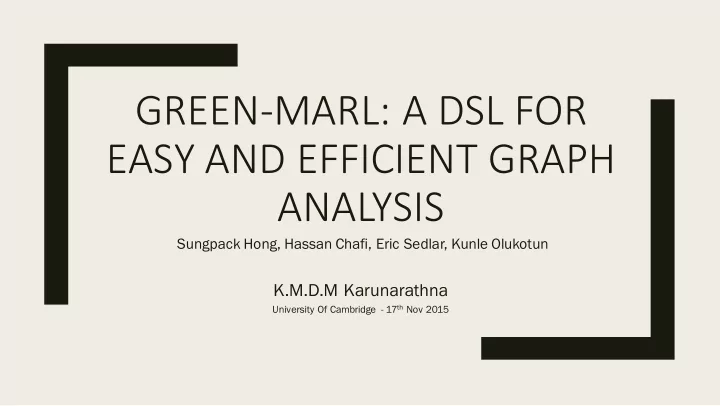

GREEN-MARL: A DSL FOR EASY AND EFFICIENT GRAPH ANALYSIS Sungpack Hong, Hassan Chafi, Eric Sedlar, Kunle Olukotun K.M.D.M Karunarathna University Of Cambridge - 17 th Nov 2015
Current Issues Issues with large-scale graph analysis ■ Performance ■ Implementation ■ Capacity
Performance Issues ■ RAM latency dominates running time for large graphs Solution : Solved by exploiting data parallelism
Implementation Issues ■ Writing concurrent code is hard ■ Race-conditions ■ Deadlock ■ Efficiency requires deep hardware knowledge ■ Couples code to underlying architecture
Solution: A DSL Green-Marl and its compiler ■ High level graph analysis language ■ Hides underlying complexity ■ Exposes algorithmic concurrency ■ Exploits high level domain information for optimisations
Example
Green-Marl Language Design ■ Scope of the Language Based on processing graph properties, mappings from a node/edge to a value - e.g. the average number of phone calls between two people ■ Green-Marl is designed to compute, scalar values from a graph and its properties • • new properties for nodes/edges selecting subgraphs (instance of above) •
Green-Marl Language Design ■ Parallelism in Green-marl Support for parallelism (fork-join style) • Implicit G.BC = 0; • Explicit Foreach(s: G.Nodes) (s!=t) • Nested p_sum *= t.B;
Language Constructs ■ Data Types and Collections - DATA a) Five primitive types ( Bool, Int, Long, Float , Double ) b) Defines two graph types ( DGraph and UGRaph ) c) Second, there is a node type and an edge type both of which are always bound to a graph instance d) e node properties and edge properties which are bound to a graph but have base-types as well
Language Constructs ■ Data Types and Collections - COLLECTION ION : Set, Order, and Sequence. a) Elements in a Set are unique while a Set is unordered. b) Elements in an Order are unique while an Order is ordered. c) Elements in a Sequence are not unique while a Sequence is ordered
Language Constructs ■ Iterations and Traversals Foreach (iterator:source(-).range)(filter) body_statement
Language Constructs ■ Deferred Assignment a) Supports bulk synchronous consistency via deferred assignments. b) Deferred assignments are denotedby <= and followed by a binding symbol
Language Constructs Reductions ■ an expression form (or in-place from) ■ an assignment form y+ = t.A;
Compiler ■ Compiler Overview User Parsing & Application Green-Marl Checking Code Front-end Transform Back-end Target Transform Code Code Gen Green-Marl Graph Data Structure Compiler (LIB) Figure. Overview of Green-Marl DSK-compiler Usage
Compiler ■ Architecture Independent Optimizations • Group Assignment • In-place Reduction • Loop Fusion • Hoisting Definitions Reduction Bound Relaxation • • Flipping Edges Foreach(s:G.Nodes)(g(s)) Foreach(t:G.Nodes)(f(t)) Foreach(t:s.OutNbrs)(f(t)) Becomes Foreach(s:t.InNbrs)(g(s)) t.A += s.B; t.A += s.B;
Compiler ■ Architecture Dependent Optimizations • Set-Graph Loop Fusion • Selection of Parallel Regions • Deferred Assignment • Saving BFS Children InBFS(v:G.Nodes; s) { ... //forward } InRBFS { // reverse-order traverse Foreach(t: v.DownNbrs) { DO_THING(t); } } Becomes _prepare_edge_marker(); // O(E) array for (e = edges ..) { for (e = edges ... ) { if (edge_marker[e] ==1) { index_t t = ...node(e); index_t t = ...node(e); if (isNextLevel(t)) { DO_THING(t); edge_marker[e] = 1; } }} } }
Compiler ■ Code Generation • Graph and Neighborhood Iteration • Efficient DFS and BFS traversals • Small BFS Instance Optimization • Reduction on Properties • Reduction on Scalars
Experiments LOC Original LOC Green-Marl Name Source BC 350 24 [9] (C OpenMp) Conductance 42 10 [9] (C OpenMp) Vetex Cover 71 25 [9] (C OpenMp) PageRank 58 15 [2] (C++, sequential) SCC (Kosaraju) 80 15 [3] (Java, sequential) Table le. Graph algorithms used in the experiments and their Lines-of-Code(LOC) when implemented in Green-Marl and in a general purpose language.
Experiments Figure. Speed-up of Betweenness Centrality. Speed-up is over the SNAP library [9] version running on a single-thread. NoFlipBE and NoSaveCh means disabling the Flipping Edges (Section 3.3 Architecture Independent Optimizations) and Saving BFS Children (Section 3.5 Code Generation) optimizations respectively.
Experiments Figure . Speed-up of Conductance. Speed-up is over the SNAPlibrary [9] version running on a single-thread. NoLM and NoSRDCmeans disabling theLoop Fusion(Section 3.3 Architecture Independent Optimizations ) andReduction onScalars(Section 3.5 Code Generation ) optimizations, respectively.
Future Works ■ Solutions for Capacity Issue ■ Comments block to green Marl ■ Combining with Graph Lab as back end.(machine learning type) ■ generate code for alternative architectures(Clusters, GPU). ■ Green Marl as internal DSL.
Pros • Easier to write graph algorithms • Algorithms perform better • Don’t need to rewrite entire application • Code is portable across platforms
Critical Evaluation • Assumes graph is immutable during the analysis
Thank you…
Recommend
More recommend